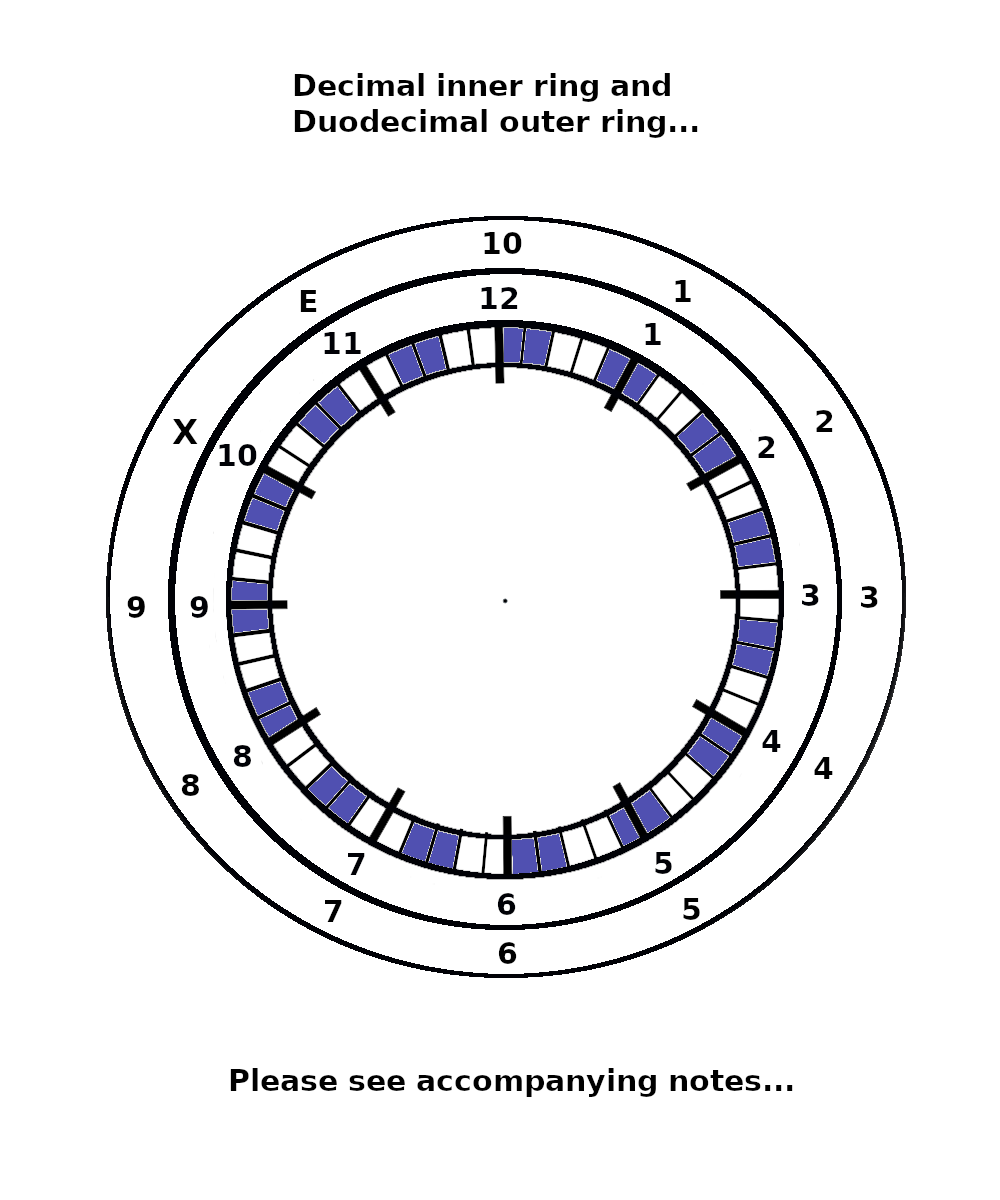
0 |
1 |
2 |
3 |
4 |
5 |
6 |
7 |
8 |
9 |
T/10 |
E/11 |
NUMBERS. |

Pic by Bing AI (!) My prompt...
(For best results, please view page in landscape).
Quick and easy version...
Note – just before you read this – what's the point?! Well, how would you like to learn a system,that makes all basic maths fractions much easier? And at the same time gives you a secret weapon for learning Music theory?! Interested?!
The thing about numbers
that I would like us to look at, is called “number bases”.
You
already know 1! Its Ten or 10 base -aka; “Decimal”.
This is the the most commonly used number base in the world. It is commonly accepted that we humans chose this base for 1 simple reason - we have ten fingers!What if we had 8 or 12 fingers?! Actually – there are number bases other than ten! There are plenty of them – and unlike most of us – mathematicians are used to working in them (were only going to look at a few)...
Later on in the TIME section – we will take a look at 60 base or
“Sexagesimal”.
You actually already know about this from the clock!60 seconds, 60
minutes etc. But for now, I would like to look at something
else...
You already know about ten base, so there is one
particular number base I would like to introduce you to...
Drum roll please ; “Duodecimal” or 12 base!
This can also be called “Dozenal” – yes, just as in a dozen eggs!And yes, you are kind of familiar with this from the clock as well...
5 minutes x 12 = 1 hour. 1 hour x 12 = full cycle of the hour hand... But more about that on the TIME page ;-)
So, I would like to compare the 2 systems side by side...
Decimal = 0 1 2 3 4 5 6 7 8 9 10
Duocimal = 0 1 2 3 4 5 6 7 8
9 X E 10
What is going on with the X and the E ?! Well, 12 base can only start again at the 12th number –so it needs 2 new numbers.
It would be confusing to call it “Ten” – so they call it “Dec”
this ties in with “Decimal”. Also, in old Roman numerals (have
you seen them) the symbol for ten was X. As for the E that stands for
Eleven and is called “El”.
Finally, that “10” at the
end, is not TEN! Its called “Do” to avoid confusion!
Quick point – there have been a number of systems recommended for the alternative version of ten and eleven – for example, some people us A and B – but personally, I think the X and E system does a pretty good job – so I’ll be using them on this site...
What about instead of Zero, we say “Oh”?
Now we have; 0 1 2
3 4 5 6 7 8 9 X E 10
Pronounced; Oh 1 2 3 4 5 6 7 8 9 Dec El
Do... Not too difficult hey?
If you wanted to continue from here, the next number would be;
11
= “Doz 1” meaning a dozen + 1 = 13 in decimal counting...
Next
up, 12 = Doz 2 = 14 in decimal...
Next up, 20 = 2 Doz =2 x 12 =
24 in decimal etc...
Next up, 21 = 2 doz 1 = (25 in decimal)
etc
Finally, 12 x 12 = 144 – written in Duodecimal like
this;
100 – and pronounced “Gross”.
There are a few versions of how to continue after this point
–but were not interested in that here...
What is the advantage of 12 base? Well its amazing for Music theory! We’ll look at that on the next page.
Its other advantage is –it makes basic fractions super easy!
Check this out;
Imagine you have 2 pies of the same size. You cut one of them into 10
peices, and the other into 12 pieces.
You are having a birthday
party, and you dont know how many are coming. You’re also not sure
which pie you will use...
Let’s start with the possible divisions of the 10 pie;
1/2 = 5 pieces each.
1/3
= 3.333 pieces each.
1/4 = 2.5 pieces each.
1/5 = 2 pieces
each.
1/6 = 1.666 pieces each.
Let’s now look at the possible divisions of the 12 pie;
1/2 = 6 pieces each.
1/3
= 4 pieces each.
1/4 = 3 pieces each.
1/5 = 2.4 pieces
each.
1/6 = 2 pieces each.
Here’s the point, out of the 5 most basic fractions; 1/2, 1/3, 1/4, 1/5, 1/6,
Decimal works well with 2 of them... Duodecimal works well with 4 of them!
In other words – if kids learned this in school –it makes basic maths (drum roll please) MUCH EASIER!!!
Now I confess, it’s too late to change to to Duodecimal...However it’s NOT too late to use it as a second - alternative number base.
If for no other reason – than to use for Music theory, and an intro to basic fractions AND number bases in school!
Finally, that's only the
basics of it – there are other advantages too –in bigger numbers
– e.g whats 1/3 of 100? 33.333...
What 1/3 of 120? 40! But
that's enough of that for now!
Here are a
few links to videos if you would like to learn more about all
this;
The first 2, are aimed at kids – but actually explain it
very well;
Vid
1
Vid
2
These are more aimed at all ages;
Vid
3
Vid
4
Vid
5
I’m going to finish this section with our first cycle
picture!

Looks familiar hey?! But with Duodecimal as well as what you're used to on a clock...
Please note, this cycle could also be displayed in a linear (in a line) fashion – like this;

1 final point to finish this section; counting, doesnt really start from “1”, it starts from “0”!
Its a small but important point – which becomes very relevant in the music section. 2 examples;
1. You start a running race, after the start of the race, half way round the 1st lap, where are you?
You havent completed lap 1 yet – you started at 0, not 1 ... 1 is after you have you have completed the 1st lap.
2. You step into a lift at the ground floor. Are you at fllor 1? No, you are at floor 0!
From
here, you can;
Go
to the next page.
Go
back to index page.
Or read on for - More details...
Believe it
or not - I am not the only saying this stuff - check these 2
out...
Dozenal
society of Great Britain
Dozenal
society of America
Now for a little history if you’re interested...
The Romans, counted upwards in blocks of 10. Even though they used a very clunky and basic system – Roman numerals. However, they did realise one thing – that division by 10 was not much good! So, they divided by 12! In fact the origin of the words “inch” and “ounce, comes from a latin word – “Uncia” which means 1/12th! The original ounce – was divided into 12 not 16.
The numbers we use today,
are taken from the Hindu/Arabic
numberal
system.They replaced Roman numerals.
They were introduced to
Europe by Fibonacci,
AKA Leonardo of Pisa -
in his 1202 book - Liber abaci.
MORE COMING HERE SOON....